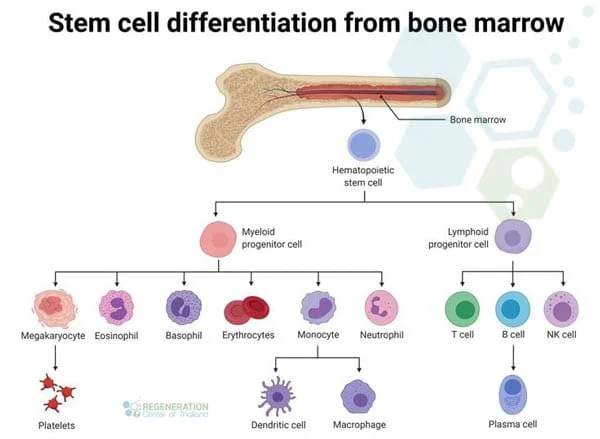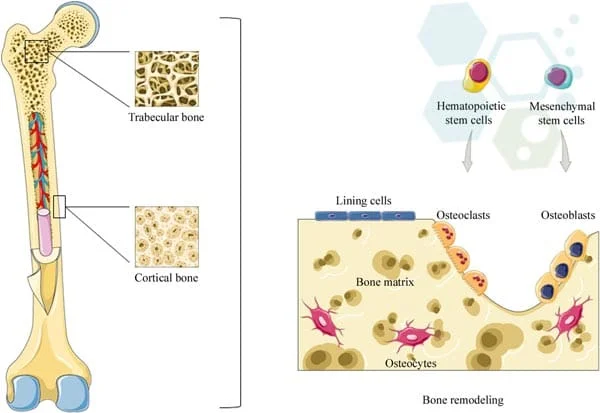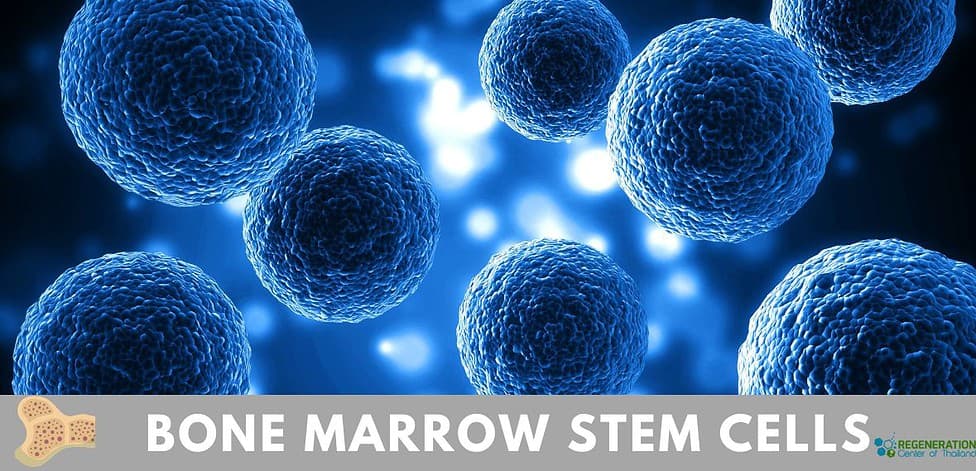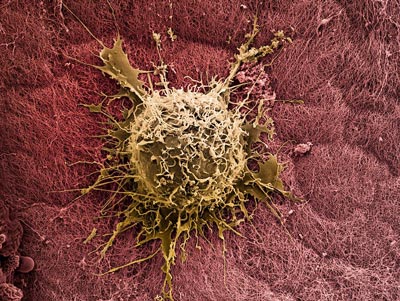Bone marrow stem cells are unique cells found in bone marrow that have the ability to develop into different types of blood and immune system cells. These multipotent stem cells are crucial in producing blood and immune cells and have shown great potential in treating various diseases and injuries.
What are Bone Marrow Stem Cells?
Bone marrow contains two main types of stem cells – hematopoietic stem cells (HSCs) and mesenchymal stem cells (MSCs).
- HSCs are multipotent stem cells that give rise to all types of blood cells, including red blood cells, white blood cells, and platelets. They are responsible for constantly replenishing blood and immune cells throughout a person’s life. HSCs are found in the soft inner part of bones called the bone marrow [1].
- MSCs are multipotent stromal cells that can differentiate into various cell types, including bone, cartilage, muscle, and fat cells. They are found in the stromal tissue of bone marrow and play a key role in supporting hematopoiesis and bone/cartilage regeneration.

Sources of Bone Marrow Stem Cells
Bone marrow stem cells can be obtained from two primary sources:
- Bone Marrow – Bone marrow is the soft, spongy tissue inside bones that contains hematopoietic stem cells. It is the primary source for harvesting HSCs for transplantation therapies. Bone marrow is extracted from the hip bones or breastbone under anesthesia. This is called bone marrow harvest or bone marrow aspiration.
- Peripheral Blood – HSCs can also be obtained from peripheral blood. Certain drugs can mobilize HSCs from the bone marrow into the bloodstream. The stem cell-rich blood is then collected from the donor’s vein in apheresis. Peripheral blood is now the most common source of HSCs for transplants. HSCs can also be collected from the umbilical cord blood of newborns. This rich source of HSCs can be banked and stored for future use [2].
Key Properties of Bone Marrow Stem Cells 
Some of the vital properties of bone marrow stem cells include:
- Self-renewal – Ability to divide and produce more stem cells
- Potency – Ability to differentiate into specialized cell types
- Multipotency – Can give rise to multiple cell types, but not all cell types
- Homing ability – Ability to migrate to sites of injury/inflammation
- Immunomodulation – Ability to modulate immune responses
These properties make bone marrow stem cells ideal candidates for cell-based therapies.
How Bone Marrow Stem Cells Work
Bone marrow stem cells work via essential mechanisms such as differentiation. Stem cells can differentiate or mature into the various blood and immune cells circulating in our body.
HSCs differentiate into two primary cell lines:
- Myeloid lineage – Leads to red blood cells, platelets, monocytes, neutrophils
- Lymphoid lineage – Leads to T-cells, B-cells, natural killer cells
Specific cell signals and growth factors regulate the differentiation process. Self-Renewable Stem cells also self-renew to maintain a constant pool of immature stem cells. This ensures the life-long production of blood and immune cells. A delicate balance of self-renewal and differentiation of HSCs is necessary to maintain blood cell homeostasis. Disruption can lead to blood disorders [3].
Role of Bone Marrow Stem Cells
 Some key roles of bone marrow stem cells include:
Some key roles of bone marrow stem cells include:
- Blood Cell Production – HSCs continuously differentiate into the various types of blood cells the body needs. This includes red blood cells, white cells, and platelets.
- Immune System Function – HSCs give rise to lymphocytes like T-cells, B-cells, and NK-cells, which are crucial for immune defense.
- Injury Response MSCs can home to sites of injury and inflammation and help in tissue repair through differentiation and paracrine signaling.
- Bone/Cartilage Regeneration – MSCs play a vital role in the regeneration and repair of bone and cartilage tissue injury in shoulders (including torn rotator cuff), knee injuries, lower back pain, spinal cord injury, osteoporosis and hip injuries.
Bone Marrow Stem Cell Transplants
Bone marrow transplantation (BMT) involves transplanting HSCs to regenerate a patient’s hematopoietic and immune system function. It is used to treat:
- Treat certain types of cancers in Blood like leukemia, lymphoma and multiple myeloma
- Genetic diseases affecting blood cells such as thalassemia and sickle cell disease [4]
- Immune deficiencies
Autologous BMT uses the patient’s stem cells, while allogeneic BMT uses donor stem cells and is more risky. Steps in BMT:
- Harvest HSCs from patient/donor
- A patient receives chemotherapy +/- radiation to ablate bone marrow for types several types of cancers
- Infuse collected HSCs into the patient’s bloodstream (bone marrow transplant)
- Transplanted healthy stem cells (HSCs) so they can home to bone marrow and regenerate the process of blood cell production
Cord Blood Banking
Umbilical cord blood is a rich source of HSCs that can be collected non-invasively at childbirth and stored in cord blood banks throughout the world. Key benefits of cells that are collected for Cord Blood Banking:
- There is no risk to the mother/infant with healthy cells
- Lower risk of viral transmission from donated cells
- Reduced likelihood of rejection from donor transplant
Cord blood stem cells and donor cells can be safely stored in our stem cell bank for up to twenty years and serve as a source of stem cells for autologous transplantation.
Bone Marrow Stem Cells in Regenerative Medicine
Bone marrow stem cells have exciting applications in regenerative medicine due to their self-renewal and multipotent properties. Current applications of Bone Marrow Stem Cells include:
- Cardiac repair after myocardial infarction & heart disease
- Treatment of neurological conditions like multiple sclerosis, stroke, traumatic brain injury, ALS, Alzheimers, and Parkinson’s disease
- Regeneration of damaged cartilage and bone
- Wound healing
- Anti-aging and rejuvenation therapies
Ongoing research at the Regeneration Center is focused on fully unlocking the therapeutic potential of these stem cells. Bone marrow contains hematopoietic and mesenchymal stem cells vital for blood/immune cell production. Their unique self-renewal, differentiation, and immunomodulation properties make them ideal for blood disorder treatments and regenerative medicine applications such as crohn’s, stem cell therapy for diabetes. Advances in stem cell transplantation and banking have expanded access to these lifesaving cells. Ongoing research focused on understanding bone marrow stem cell biology promises to uncover novel cellular therapies for many incurable diseases [5].

The cost and accessibility of bone marrow stem cells can be a significant barrier for some patients. Depending on scale and severity stem cell treatments can be expensive, and not all insurance plans cover it. Finding a suitable donor can also be challenging, especially for some patients especially for this with unique blood-types or those from underrepresented ethnic backgrounds. Efforts to increase testing and access to donor registries around the world are vital to improving accessibility and providing life-saving treatments to more patients.
Bone Marrow Mesenchymal stem cells have proven to be a valuable resource in treating various medical conditions, from blood disorders to autoimmune diseases and cancers. While there are challenges to address, the potential applications of using autologous bone marrow stem cells will continue to grow, offering hope for improved treatment protocols and better patient outcomes.
Published Clinical Citations
[1] ^Purwaningrum M, Jamilah NS, Purbantoro SD, Sawangmake C, Nantavisai S. Comparative characteristic study from bone marrow-derived mesenchymal stem cells therapies in Thailand. J Vet Sci. 2021 Nov;22(6):e74. doi: 10.4142/jvs.2021.22.e74. Epub 2021 Aug 26. PMID: 34697921; PMCID: PMC8636658.
[2] ^ Morrison SJ, Scadden DT. The bone marrow niche for haematopoietic stem cells. Nature. 2014 Jan 16;505(7483):327-34. doi: 10.1038/nature12984. PMID: 24429631; PMCID: PMC4514480.
[3] ^ Archacka K, Grabowska I, Mierzejewski B, Graffstein J, Górzyńska A, Krawczyk M, Różycka AM, Kalaszczyńska I, Muras G, Stremińska W, Jańczyk-Ilach K, Walczak P, Janowski M, Ciemerych MA, Brzoska E. Hypoxia preconditioned bone marrow-derived mesenchymal stromal/stem cells enhance myoblast fusion and skeletal muscle regeneration. Stem Cell Res Ther. 2021 Aug 9;12(1):448. doi: 10.1186/s13287-021-02530-3. PMID: 34372911; PMCID: PMC8351116.
[4] ^ Dharmasaroja P. Bone marrow-derived mesenchymal stem cells for the treatment of ischemic stroke. J Clin Neurosci. 2009 Jan;16(1):12-20. doi: 10.1016/j.jocn.2008.05.006. Epub 2008 Nov 18. PMID: 19017556.
[5] ^ van Noorden CJF, Breznik B, Novak M, van Dijck AJ, Tanan S, Vittori M, Bogataj U, Bakker N, Khoury JD, Molenaar RJ, Hira VVV. Cell Biology Meets Cell Metabolism: Energy Production Is Similar in Stem Cells and in Cancer Stem Cells in Brain and Bone Marrow. J Histochem Cytochem. 2022 Jan;70(1):29-51. doi: 10.1369/00221554211054585. Epub 2021 Oct 29. PMID: 34714696; PMCID: PMC8721571.


